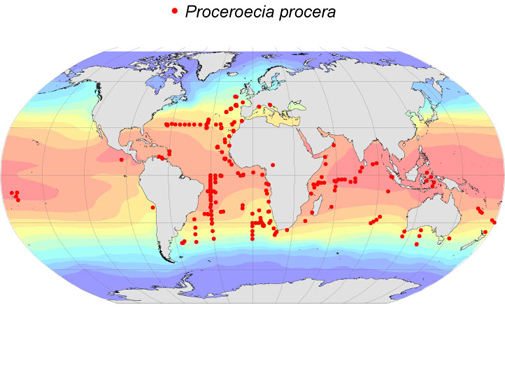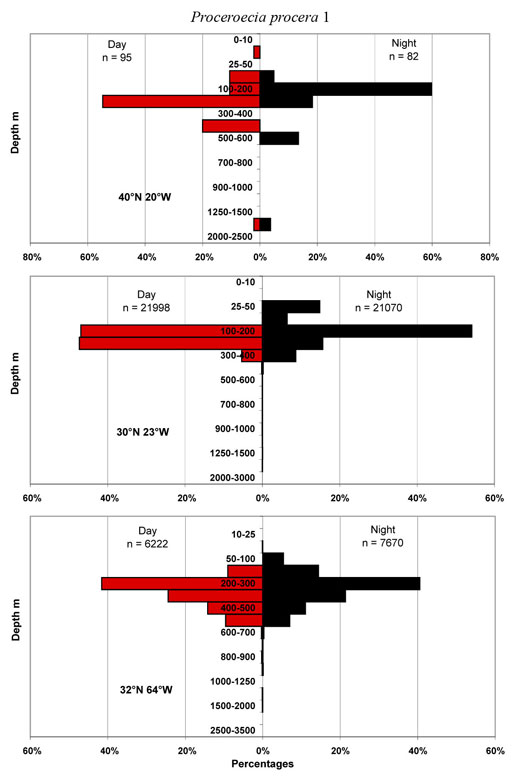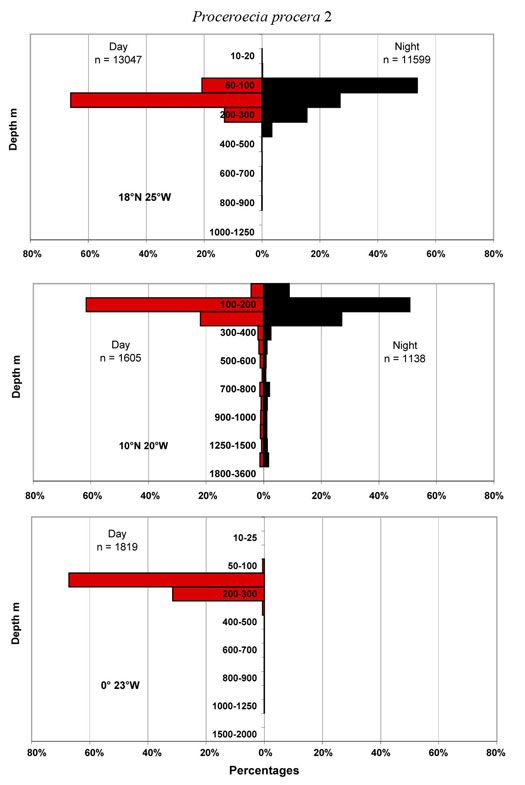Notes
471 records
This species is often extremely abundant at shallow mesopelagic depths throughout tropical and subtropical oceans. It turns up occasionally in small numbers in temperate waters in the Northeast Atlantic possibly advected in the northward flow of the North Atlantic Drift. Its known latitudinal range is 50°N to 44°N, but it is most abundant at latitudes <40°. It was originally described from the Mediterranean, by Müller who pointed out that it had previously been confused with Conchoecia variabilis Muller 1890 and Conchoecia oblonga Claus 1890. Superficially, it is easy to confuse it with Form B of Paraconchoecia oblonga, since both species have the right asymmetrical gland located a little anterior to the posterior ventral corner. Angel (1971) showed that in the North Atlantic at least three species were contained within the original species concept, and subsequently a number of subspecies have been described from the Mediterranean. Thus all records from earlier than 1971 should be treated with caution and may include one or more of the other species, or even yet further cryptic species. This species complex would benefit from investigation using molecular techniques. Poulsen (1973) classified this species in Kock (1992) pointed out that the species originally in Müller’s ‘procera group’ differed from the other Paraconchoecia species, and erected the new genus Proceroecia to accommodate them.Proceroecia macroprocera was designated as the type species. The bathymetric profiles show that its depth range is usually 50-400m and a small proportion of the population migrates up at night into the epipelagic.
Living animals are translucent and either colourless or very lightly tinted with yellow and orange pigments.
| Equator
|
n
|
Mean mm
|
s.d.
|
Range mm
|
|---|
| Female
|
179
|
1.02
|
0.364
|
1.08-1.22
|
|---|
| Male
|
218
|
1.00
|
0.120
|
0.96-1.06
|
|---|
| A-1
|
139
|
0.82
|
0.191
|
0.82-0.92
|
|---|
| A-2
|
|
|
|
|
|---|
| Bermuda
|
n
|
Mean mm
|
s.d.
|
Range mm
|
|---|
| Female
|
216
|
1.17
|
0.028
|
1.10-1.24
|
|---|
| Male
|
216
|
1.00
|
0.025
|
0.94-1.08
|
|---|
| A-1
|
216
|
0.89
|
0.026
|
0.82-0.96
|
|---|
| A-2
|
|
|
|
|
|---|
| Azores Front
|
n
|
Mean mm
|
s.d.
|
Range mm
|
|---|
| Female
|
100
|
1.12
|
0.050
|
0.98-1.30
|
|---|
| Male
| 92
|
0.98
|
0.031
|
0.90-1.04
|
|---|
| A-1
|
86
|
0.85
|
0.031
|
0.76-0.98
|
|---|
| A-2
|
|
|
|
|
|---|
| 44°N
|
n
|
Mean mm
|
s.d.
|
Range mm
|
|---|
| Female
|
39
|
1.21
|
0.041
|
1.12-1.26
|
|---|
| Male
| 4
|
1.19
|
0.009
|
1.18-1.20
|
|---|
| A-1
|
20
|
0.96
|
0.189
|
0.84-1.04
|
|---|
| A-2
|
|
|
|
|
|---|
| Indian Ocean
|
n
|
Mean mm
|
s.d.
|
Range mm
|
|---|
| Female
|
203
|
1.02
|
0.029
|
0.90-1.08
|
|---|
| Male
|
47
|
0.90
|
0.025
|
0.84-0.96
|
|---|
| A-1
|
66
|
0.79
|
0.025
|
0.72-0.84
|
|---|
| A-2
|
|
|
|
|
|---|






